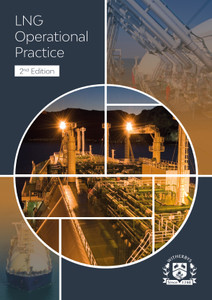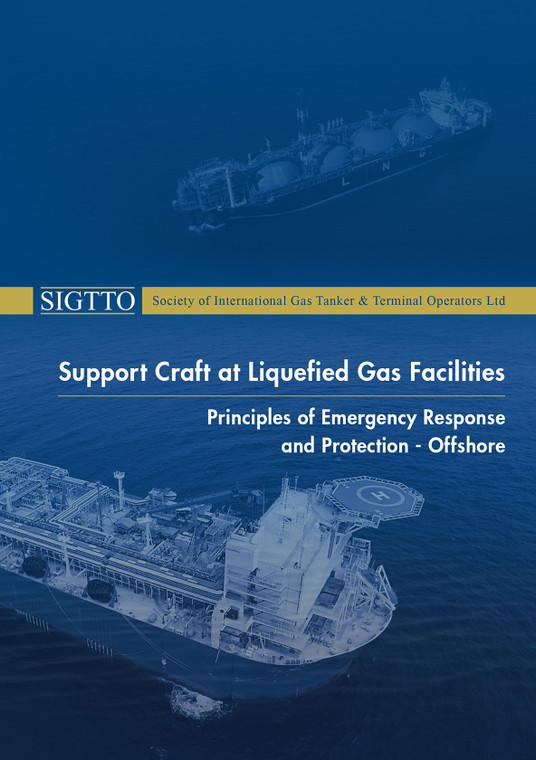
This SIGTTO publication is about the role of support craft in assisting with safe operations and emergency response for liquefied gas carriers and facilities. It looks at how the service could be improved by a more up to date approach and an improved understanding of hazards, barriers, risk scenarios and response strategies. It provides suggested competency standards to assist with the creation of training programmes for support craft crew.
This book demonstrates how risk assessment may be used to develop response and protection strategies for support craft. It considers the ‘top events’ that will typically concern operators of support craft (i.e. loss of containment, collision/grounding, loss of position, and evacuation, rescue and pollution prevention) and discusses the threats, barriers and consequences of each event, highlighting the part that support craft can play in mitigating risk through planning and operational readiness.
The text is supported with colour illustrations and photographs, as well as diagrams showing the ‘bowtie’ method of risk assessment and management.
Annexes provide useful information on:
- Response considerations and planning
- equipment and capabilities of support craft
- water-spray systems
- support craft emergency response competencies
- fire and gas dispersion modelling.
This title incorporates A Contingency Planning and Crew Response Guide for Gas Carrier Damage at Sea and in Port Approaches, 3rd Edition (SIGTTO) and A Guide to Contingency Planning for the Gas Carrier Alongside and Within Port Limits, 2nd Edition (SIGTTO).
Support craft perform a vital role in assisting with safe operations and emergency response for liquefied gas carriers and facilities. The effectiveness of the service provided by support craft could be improved by a more up to date approach and an improved understanding of the hazards, barriers, credible scenarios and credible response strategies.
Throughout this document the term ‘facility’ is used to describe an offshore liquefied gas facility.
The information in this document is provided primarily for organisations involved in the transportation of liquefied gas cargoes, including support craft, facilities and ships. It may also be of assistance to regulators and government agencies. Suggested competency standards have been provided, at Annex D, to assist with the creation of training programmes for the crew of support craft.
It is important to understand that this document does not cover all possible scenarios, nor does it address each scenario to the fullest extent possible. This is because each circumstance may be different and the user is only guided on the possible approach and general principles to consider when creating an emergency response plan. The user will need to consider additional industry guidance, regulatory requirements and other sources of information to build an effective response plan.
This document uses a risk assessment method and terminology, which is discussed in Section 1.3, to explain the environment and define some example scenarios and response strategies.
All of the responses contained in this document are based on the following order of priority: protection of life, the environment and property. Protection of life has been considered not only in the context of the ship and facility staff involved in a cargo operation, but also in the context of emergency responders and the general public in the vicinity.
Evaluating a scenario without understanding the design barriers built in to reduce risk may lead to an improbable conclusion being reached.
Knowledge of the design basis for facilities and gas carriers, including typical credible (design) scenarios, may assist in the improvement of existing practice. This document, therefore, sets out to increase awareness of the philosophy behind the design, including the purpose and limitation, of equipment used. Appreciation of the credible scenarios should also assist the industry in carrying out more effective drills and exercises.
The Annexes contain further information that may assist with improving emergency response. Based on the range of scenarios a support craft could encounter, the suggested competency standards provided at Annex D may assist with the effectiveness of the response strategy. Relevant information is provided about some of the equipment used in emergency response and its potential effectiveness. Readers are also encouraged to refer to
the publications listed in the References, as they may provide further relevant information.
SIGTTO acknowledges that its ability to provide effective guidance is the result of industry wide consultations. We welcome any comments or suggestions for improvements that could be considered for inclusion in future editions.
Part
1:
Scope
and
Methodology
1.
Introduction
Part 2: Assessing the Risk and the Management of Specific Events
2. The Operating Environment
3. Top Events
Annexes
Annex A – Response Considerations and Planning
Annex B – Equipment and Capabilities of Support Craft
Annex C – Water-spray Systems
Annex D – Support Craft Emergency Response Competencies
Annex E – Fire and Gas Dispersion Modelling
Annex F – Properties of Liquefied Gases
Annex G – Glossary of Terms and Abbreviations
Annex H – References
The Society of International Gas Tanker and Terminal Operators (SIGTTO) is an international body established for the exchange of technical information and experience, between members of the industry, to enhance the safety and operational reliability of gas tankers and terminals.
- Number of Pages:
- 93
- ISBN:
- 9781856097154
- Binding Format:
- Hardback
- Book Height:
- 300 mm
- Book Width:
- 215 mm
- Weight:
- 0.8 kg
- Author:
SIGTTO
- Published Date:
- October 2016
- Preview:
- Yes
- Publication Date:
- October 2016






